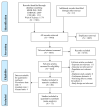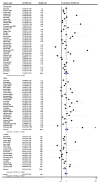Occupational Risk in Knee Osteoarthritis: A Systematic Review and Meta-Analysis of Observational Studies
- PMID: 32638548
- PMCID: PMC7116019
- DOI: 10.1002/acr.24333
Occupational Risk in Knee Osteoarthritis: A Systematic Review and Meta-Analysis of Observational Studies
Abstract
Objective: To assess the association between occupational exposures and knee osteoarthritis (OA).
Methods: We systematically searched for observational studies that examined the relationship between occupational exposures and knee OA and total knee replacement. Four databases were searched up to October 1, 2019. Two reviewers independently assessed study quality using the Newcastle-Ottawa Scale and evidence quality using the Grading of Recommendations Assessment, Development and Evaluation approach. Subgroup meta-analyses were conducted for important study characteristics and each type of occupational exposure. Odds ratios (ORs) and 95% confidence intervals (95% CIs) were estimated for the meta-analysis using random-effects models.
Results: Eighty eligible studies were identified including 25 case-control (n = 20,505 total participants), 36 cross-sectional (n = 139,463 total participants), and 19 cohort studies (n = 16,824,492 total participants). A synthesis of 71 studies suggested increased odds of knee OA (OR 1.52 [95% CI 1.37-1.69]) by combining different physically demanding jobs and occupational activities as compared to sedentary occupations and/or low-exposure groups. Odds of knee OA were greater in males and in industry-based studies and studies assessing lifetime occupational exposures. There were 9 specific job titles that were associated with knee OA, including farmer, builder, metal worker, and floor layer. Occupational lifting, kneeling, climbing, squatting, and standing were all associated with higher odds of knee OA as compared to the odds of knee OA in sedentary workers.
Conclusion: Strenuous, physically demanding occupations and occupational activities were associated with increased odds of knee OA as supported by moderate-quality evidence. Specifically, agricultural and construction sectors, which typically involve heavy lifting, frequent climbing, prolonged kneeling, squatting, and standing, carried increased odds of knee OA.
© 2020, American College of Rheumatology.
Conflict of interest statement
Professor Hunter provides consulting advice for Pfizer, Lilly, TLC bio and Merck Serono. Professor Arden reports grants from Merck, personal fees from Merck, Flexion, Regeneron and Pfizer/Lilly outside the submitted work. Professor Cooper reports personal fees from Alliance for Better Bone Health, Amgen, Eli Lilly, GSK, Medtronic, Merck, Novartis, Pfizer, Roche, Servier, Takeda and UCB. All the other authors have no conflicts of interest to disclose.
Figures



References
-
- Palazzo C, Nguyen C, Lefevre-Colau MM, Rannou F, Poiraudeau S. Risk factors and burden of osteoarthritis. Ann Phys Rehabil Med. 2016;59(3):134–8. - PubMed
-
- Holmberg S, Stiernstrom EL, Thelin A, Svardsudd K. Musculoskeletal symptoms among farmers and non-farmers: A population-based study. International Journal of Occupational and Environmental Health. 2002;8(4):339–45. - PubMed
-
- Jensen LK, Mikkelsen S, Loft IP, Eenberg W, Bergmann I, Logager V. Radiographic knee osteoarthritis in floorlayers and carpenters. Scand J Work Environ Health. 2000;26(3):257–62. - PubMed
-
- Tennant LM, Chong HC, Acker SM. The effects of a simulated occupational kneeling exposure on squat mechanics and knee joint load during gait. Ergonomics. 2018;61(6):839–52. - PubMed
Publication types
MeSH terms
Grants and funding
LinkOut - more resources
Full Text Sources
Medical

